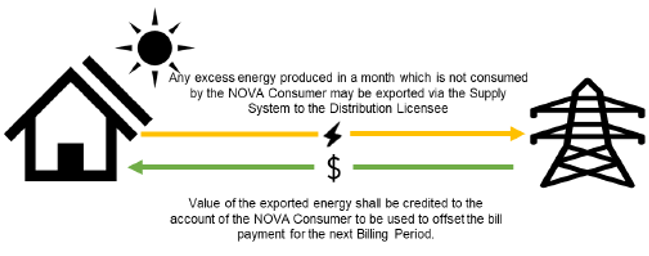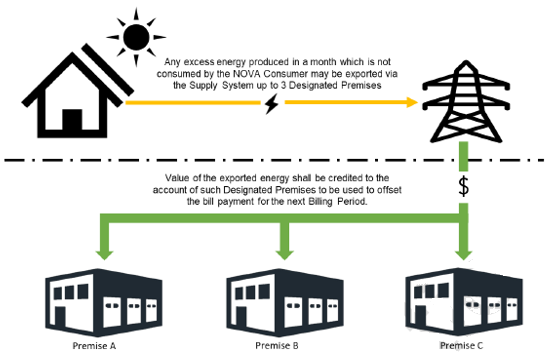What NOVA stands for and what is the programme about?
NOVA stands for Net Offset Virtual Agrregation (NOVA).
The concept of NOVA Programme is that the energy produced from the solar PV installation on a NOVA consumer Premise shall be consumed and designed primarily for self-consumption.
Any excess Energy which is not consumed at the Premise where the PV Installation is located may be exported through the Supply System under one of the following categories:
Category A
Any excess Energy produced in a month which is not consumed by the NOVA Consumer may be exported via the Supply System to the Distribution Licensee.The value of the exported Energy shall be credited to the account of the NOVA Consumer to be used to offset the bill payment for the next Billing Period.
Category B
Any excess Energy produced in a month which is not consumed by the NOVA Consumer may be exported via the Supply System to up to three (3) Designated Premises. The value of the exported Energy shall be credited to the account of such Designated Premise to be used to offset the bill payment for the next Billing Period.
Please see FAQ No.3 & 5 for more details on the categories.
What are the types of installation eligible under NEM NOVA?
The solar PV installation shall be of PV panels mounted on the rooftop of the buildings within the same Premise
What is the maximum capacity limit per application?
The maximum capacity of the PV Installation for each category shall be based on the Maximum Demand of the NOVA Consumer.
| Programme | Capacity limit |
| Category A |
A NOVA Consumer under Category A shall not install more than 1,000kW for net offset and subject to the following conditions: a) The maximum capacity of the inverter output of the solar PV Installation shall not be more than 75% of Maximum Demand of the NOVA Consumer under the NOVA Contract. b) The Maximum Demand of the NOVA Consumer is based on: i) the average of the recorded Maximum Demand of the past twelve (12) months; or ii) the declared Maximum Demand for NOVA Consumers with less than twelve (12) months record. c) For low voltage Consumers, the maximum capacity limit is 60% of fuse rating (for direct meter) or 60% of current transformer (CT) rating. |
| Category B |
A NOVA Consumer under Category B shall not install more than 5,000kW for net offset and virtual aggregation and subject to the following conditions: a) The maximum capacity of the inverter output of the solar PV installation shall not be more than 100% of Maximum Demand of the NOVA Consumer under the NOVA Contract. b) The Maximum Demand of the NOVA Consumer is based on: i) the average of the recorded Maximum Demand of the past twelve (12) months; or ii) the declared Maximum Demand for NOVA Consumers with less than twelve (12) months record. c) For low voltage Consumers, the maximum capacity limit is 60% of fuse rating (for direct meter) or 60% of current transformer (CT) rating. |
Is there any tenure in the NEM contract between the DL and the NEM approval holder?
The NOVA Consumer shall enter into a NOVA Contract with the Distribution Licensee before the Commencement Date. The offset part of electricity bills will be for a period of ten (10) years on commencement of the NOVA Contract. Within the period, the NOVA Consumer is allowed to roll-over any excess Energy generated for every month. After the ten (10) years period, the solar PV installation shall be strictly for self-consumption in the premise where the solar PV installation was installed. The NOVA Contract is deemed to commence on the installation of the meter by the Distribution Licensee
Will the owner be able to cash out the excess energy generated each month?
There will be no cash transaction under the NEM NOVA. Instead, any excess Energy which is not consumed at the Premise where the PV Installation is located due to operational constraints or monthly or seasonal variation in load demands at the said Premises may be exported through the Supply System under one of the following categories:
Category A
- Any excess Energy produced in a month which is not consumed by the NOVA Consumer may be exported via the Supply System to the Distribution Licensee.
- The value of the exported Energy shall be credited to the account of the NOVA Consumer to be used to offset the bill payment for the next Billing Period.
- The unit price (RM/kWh) of the Energy exported in the Billing Period to the Supply System shall be based on the Average SMP.
- Only excess Energy exported in the month can be used to offset bill payment for the next Billing Period and any remaining excess Energy shall be forfeited.
- The value of the credit cannot be used to offset the minimum monthly charge as stated in the tariff schedule.
- A NOVA Consumer under Category A is as illustrated in Figure 1 below:

Category B
- Any excess Energy produced in a month which is not consumed by the NOVA Consumer may be exported via the Supply System up to three (3) Designated Premise.
- The value of the exported Energy shall be credited to the account of such Designated Premise to be used to offset the bill payment for the next Billing Period.
- The unit price (RM/kWh) of the Energy exported in the Billing Period to the Supply System shall be based on the Average SMP.
- Only excess Energy exported in the month can be used to offset bill payment for the next Billing Period and any remaining excess shall be forfeited. The value of the credit cannot be used to offset the minimum monthly charge as stated in the tariff schedule.
- For the purpose of Category B, a Designated Premise of the NOVA Consumer includes Premise used or operated by its wholly owned subsidiary company.
- To facilitate the accounting and the settlement, all these Premises shall have the same Billing Period.
- NOVA Consumer under the Category B is as illustrated in Figure 2 below:

What is System Marginal Price (SMP)? And How SMP is calculated?
System Marginal Price (SMP) is defined in the Guidelines For Single Buyer Market (Peninsular Malaysia) as :
“The price of the most expensive marginal generator included in the Draft Day Ahead Dispatch Schedule to meet the Day Ahead Load Forecast in a Half-Hour Period or the Week Ahead Dispatch schedule to meet the Week Ahead Load Forecast.”
Average SMP – means the monthly average SMP for the daily period between 7:00 hour to 19:00 hour in the preceding calendar month;
Under the NOVA Programme, the credit to the NOVA Consumer shall be based on the Average SMP. The calculation for net offset amount of Energy shall be based on the following calculation and shall not be used to offset the minimum monthly charge as stated in the tariff category of the Distribution Licensee:
Net Energy charge (RM) = (Energy imported from Supply System* x prevailing gazetted Energy rate) – (Energy export to Supply System x Average SMP)
*the Energy imported is subjected to SST, KWTBB, ICPT, where applicable.
The excess export Energy for Designated Premise will be aggregated to the Designated Premise’s accounts based on priority set by NOVA Consumer.
The Single Buyer shall publish the Average SMP of the preceding month on its website no later than the 14th day of every month
Is NEMAS required for NEM NOVA? What are the details?
Under NEM NOVA, the NEM Assesment Study (NEMAS ) is being replaced with Connection Assesment Study (CAS). A Connection Assesment Study (CAS) is required for all applications with solar PV installation with peak capacity exceeding 72kW in order to check the acceptability of the installation to be connected to the Supply System. It is the responsibility of the Applicant to bear the costs of the CAS.
The CAS is a pre-requisite for the approval of application to the NOVA Programme and is required to be conducted prior to the approval of the application. If the result of the study demonstrates the need for any modification to the Supply System for the connection of the solar PV Installation, it is the responsibility of the Applicant to bear all costs of such modification works by the Distribution Licensee or Grid Owner.
The CAS for Low Voltage and Medium Voltage may be conducted or caused to be conducted by the Distribution Licensee or any party endorsed by the Distribution Licensee.The CAS for High Voltage can be conducted or caused to be conducted by the Grid Owner or any party endorsed by the Grid Owner.
The Distribution Licensee shall provide the relevant data of the Supply System to the party appointed by the Applicant to conduct the study subject to execution of a Non-Disclosure Agreement between the party that will carry the study and the Distribution Licensee or the Grid Owner.
The result of the CAS is valid from one (1) year from the date of approval of the study.
The fees for the study is shown below:
| Installed Capacity (kW) | Study Required | Fees of Study |
| For Installations at Low Voltage (LV) & Medium Voltage (MV) | ||
| 1 – 72kW | No | – |
| >72kW – 180kW | Yes | RM 1,000 |
| >180kW – 425kW | Yes | RM 5,000 |
| >425kW – 1,000kW | Yes | RM 8,000 |
| >1,000kW – 2,000kW | Yes | RM 15,000 |
| >2,000kW – 5,000kW | Yes | RM 20,000 |
| For Installations at High Voltage (HV) | Yes | Determined by the consultant |
Table 1: Fees for Connection Assesment Study (CAS)
I have obtained NEMAS approval but did not secure any quota for NEM 2.0. Can I still use the NEMAS approval for NEM 3.0?
As long as the NEMAS is still valid and there is no change capacity, Applicant will need to obtain an approval letter from the DL confirming the use of the NEMAS for NEM NOVA application. Any change exceed the capacity from the approved NEMAS will need to do a new CAS study.
What are the required information & documents for NEM application?
Information:
- Applicant’s profile;
- Project Information;
- Technical Information;
- Proposed work plan;
Documents:
- Detailed Engineering Design endorsed by Competent Person;
- Latest electricity bill (Latest 3 months) or invoice by TNB;
- Connection Assesment Study (CAS) Approval and report (For capacity above 72kW)
- Document proofing site ownership

